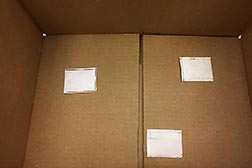| Read the magazine story to find out more |
|
|
Chlorine Dioxide Pouches Can Make Produce Safer and Reduce Spoilage
July 17, 2017
A small plastic pouch, half the size of a credit card, could soon make the nation's produce safer by killing off pathogens that make people sick. The pouch, developed with help from Agricultural Research Service (ARS) scientists, releases chlorine dioxide gas, which eliminates E. coli and other pathogens from the surfaces of fruits and vegetables.
Worrell Water Technologies of Delray Beach, Florida, hopes to market the product to produce wholesalers and packers in the United States and overseas. The pouches are used by packing them in shipping containers with produce.
Jinhe Bai and his colleagues at ARS's U.S. Horticultural Research Laboratory in Fort Pierce, Florida, worked with Worrell to develop the pouch idea, and designed a polyethylene terephthalate ("PET") clamshell to house it.
E. coli and other pathogens on produce surfaces can cause illness if the produce isn't well washed or cooked. As a preventive measure, chlorine, chlorine dioxide gas and other sanitizers are often used to sanitize produce. But chlorine dioxide packaged in a proprietary plastic pouch, and designed to be used by packing houses and produce wholesalers, is a first.
The pouch has a semi-permeable membrane that vents the gas at a controlled rate.
When Bai and his colleagues put the pouches into cartons of grapefruit using typical packing, shipping and storage conditions, they found 10 times fewer bacterial and fungal pathogens than on grapefruit stored without pouches. Tests also showed a 100,000-fold reduction in E. coli levels in inoculated grape tomatoes stored with the pouches, according to Bai.
A panel of ARS volunteers in Fort Pierce also found treatments didn't change the produce's appearance or taste.
The pouches are cost effective and only one to three are needed per crate or carton. The pouches might sanitize other produce, although further studies are needed to determine effectiveness on other specific fruits and vegetables, Bai notes. Study results were published January 2017 in HortScience.
You can read more about this research in the July 2017 issue of AgResearch magazine.
For more information contact Dennis O'Brien, ARS Office of Communications.
The Agricultural Research Service is the U.S. Department of Agriculture's chief scientific in-house research agency. Daily, ARS focuses on solutions to agricultural problems affecting America. Each dollar invested in agricultural research results in $17 of economic impact.

